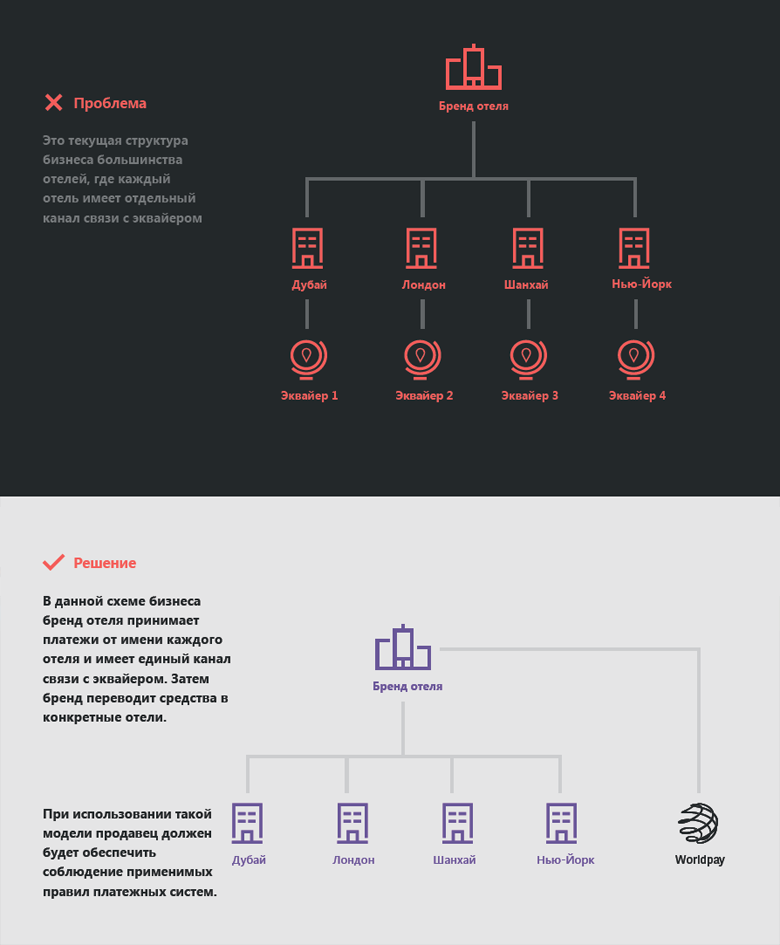Why payments are at the heart of tourist experience
The report presented in this material discusses how airlines, travel agencies operating online, as well as hotels and suppliers of tourism products can make traveling easy and enjoyable through proper payment organization:
- Implement payment optimization at all stages of the booking process.
- Adjust business models and payment processes.
- Focus on payments as the basis of a customer satisfaction strategy.
Travelers at hand have all the comprehensive information. Whether they are viewing tour offers on their smartphone on their way to work or reading blogs about weekend trips - thoughts of vacation are always the first to come to their mind.
')
There are three main areas where an integrated approach to payments can improve sales.
The first is at the initial stage of booking. Products and prices are often the same for different tour providers, so user experience is the key difference. The easy booking process plays a crucial role when travelers choose between the company and its competitors. The visitor becomes a client only after having parted with his money.
Secondly, it is very important that the process of making payments is absolutely easy for your customers. But that is not all. After the customer clicks on the “Pay Now” button, the transaction must be checked for fraud and approved by the payment service provider before it can be considered a profit. This is a direction with great optimization possibilities to maximize the level of conversion and profit.
Third, airlines and tour operators can expand their relationship with their customers beyond the initial booking and increase their share of travel expenses. This can be done by offering additional travel products and services throughout the journey and ensuring the ease of making their purchases by simply swiping your finger across the screen of the phone.
Do you offer the best payment method to stand out from competitors?
Making payments
Travel is not confirmed until the payment. Travel service providers make considerable efforts to optimize the booking process, but many ignore the importance of the payment stage and, as a result, lose a lot of profit.
The payment page, of course, is important, but it is not the only thing to pay attention to. Here are some tips to help you.
Five ways to improve the process of making payments online:
- Inform customers about what payment methods are offered by the service provider on the home page of the site so that they immediately know that they can use their favorite payment method.
- Allow customers to choose their preferred currency, since 25% of visitors will not complete the payment process if their home currency is not available when paying.
- Create convenient payment pages - reduce the number of fields in which you need to enter data, and configure automatic filling of data as possible.
- Instill more confidence in your customers by posting security certificates of the payment system and sending notifications about payment status / payment confirmation via email after a successful or unsuccessful transaction. 97% of people told us that they expect to receive an email after making a payment.
- In case of problems, optimize the recycle bin recovery if the payment failed, and arrange for payment issues.
Mobility is a revolutionary step.
Thanks to 4G, free Wi-Fi and cheap roaming, mobile phones have become the best friends of travelers who use them not only to search for information, but also to instantly pay for additional travel services.
“Mobility orientation” has long become a mantra in the retail sector, but tour operators are still not keeping up with innovation. Asia today is leading the mobile revolution in the tourism industry - according to a recent Worldpay survey, every third Chinese traveler booked his trip from a smartphone, while in Germany only every hundredth person does.
The process of payment from mobile devices is more complicated, but travel companies can not afford to make a mistake.
Online taxi services and limousines have become the benchmark for the process of purchasing transportation services from a mobile phone. No matter where you are in the world, you can place an order and pay for it from your phone using the saved payment details and a couple of screen touches. This is an extremely easy to use interface.
Consumers using smartphones are now organizing their own journey, deciding where they want to be and what they want to see, by simply touching the screen or pressing a key.
Five ways to improve the process of making payments online:
- Optimize your payment pages for mobile devices and minimize the amount of data you need to enter.
- Find a balance between risk and user-friendliness and periodically disable 3D Secure checks for low-cost or loyal customer transactions.
- If you offer alternative payment methods, then make sure that their use is optimized for mobile devices.
- Allow customers to store their payment details in their profile by selecting this option during the first payment - this will allow you to pay for any subsequent purchases without re-entering data.
- Loyalty to your site will increase if travelers can make payments on the go with one touch of the phone screen. If you redirect your customers to a third-party provider to complete the booking and payment, the conversion rate will decrease, because it creates inconvenience for users.
How to optimize the payment process:
- Find a balance between anti-fraud and user-friendliness to maximize payment approval. For example, set up a dynamic shutdown of 3D Secure depending on the cost of the transaction, the traveler profile and the booking channel.
- Choose between local and international acquiring to find a balance between expenses and the level of approval of payments.
- Provide tier 2 and tier 3 data — mark transactions to help increase payment approval rates and lower interbank fees.
Online Travel Agencies (OTA)

How this model works:
- Traveler A booked a family holiday on the OTA website
2 days before departure, they offer him parking at the airport and access to the comfort lounge through an application on a mobile phone. - During the holidays, the OTA mobile app recommends you go to river rafting based on the weather forecast, - Traveler A pays for it with his fingerprint.
- Traveler A wants to extend his vacation for one more day. His hotel and flight are automatically updated with one click.
- Online travel agencies (OTA) are commonly referred to as “travel supermarkets.” Customers make a one-time payment for a package of travel services, and everything will be ready from the moment they leave for the airport until they return.
OTA defaults are best for offering additional travel services when traveling. Anyone who is engaged in receiving payment on behalf of the final service provider can organize the perfect easy and enjoyable journey. This avoids the problems that may arise when redirecting customers to a third-party site for payment.
Airlines

How this model works:
- Traveler B booked a flight on the airline's website.
- He arrives late at the airport, so he is offered an expedited escort service through the search area with the help of the saved map data.
- Traveler B sees in the plane advertising theater tickets and buys them on board.
- When he lands, the airline sends him a push notification of the transfer to the hotel using GPS - he pays for it in one click.
Airlines should take advantage of this opportunity and sell useful services by offering simple payment methods.
Services such as payment at check-in desks, self-service kiosks and employees serving passengers while they are waiting in a queue will allow increased access to points of interaction with customers before and after the flight. Airplane Wi-Fi also allows customers to pay for services at their destination — for example, tours and activities — right on board.
The interaction of airlines with passengers has grown from the initial booking to the planning of the trip, and now they need to continue to interact during the entire trip. The preservation of payment details and coverage of the payment flow are an integral part of the easy sale of ancillary services, and this opportunity should not be missed.
Hotels

How this model works:
- Traveler B makes a reservation on the hotel website.
- When she drives to the hotel by taxi, automatic registration begins and a room upgrade is offered. She buys it with one touch of the screen, using the previously saved data of her card.
- Room key is generated on the mobile device.
- Traveler B booked a day at the spa and theater tickets using her mobile device in one click, since all her payment details are safely stored.
The hotel sector is currently not keeping pace with innovations in terms of offering customers an easy payment method. The reason is usually in business organization.
When a customer makes a hotel reservation, his payment information is recorded and redirected to the hotel of his choice.
This data is usually stored only for reservations, and payment is charged only in case of no-show. During registration, the guest must complete a separate payment process.
To develop an easy and convenient booking and registration process that would work in all hotels of a brand or group, the hotel industry must move away from the existing “specific hotel” payment system and move to a centralized model.
The booking confirmation can be completed “with one click, and guests can automatically register when they approach the hotel building using their saved payment details.
It will also allow the guest to change and cancel individual services on their booking without having to negotiate with several parties.
For this to work, it is necessary for the hotel brand to take responsibility for the flow of payments and become a contractor or registered seller, while complying with all applicable payment system rules. Hotels need to go further and begin to manage payments centrally, becoming essentially a hotel “Internet seller”.
Of course, accepting payment for bookings and additional services also means taking on additional responsibilities, such as entering into an agreement with an acquirer, managing a complex payment process and organizing a subsequent flow of funds.

Market of tourist products
How this model works:
- Traveler G orders a taxi through the app and pays for the trip with one click.
- Taxi arrives at GPS coordinates.
- Traveler G arrives at the destination, and payment is automatically processed.
What seems easy, simple and invisible to the client, hides behind itself the complex world of the payment infrastructure with three main components:
The first is to allow new customers to choose from a wide range of payment methods in their user profile. This is followed by a set of payment transactions before, during and after the trip, ensuring the authenticity of transactions and preventing fraud.
The second is the management of the flow of money between the client, the market, and the individuals who will ultimately receive their share of the provision of travel services. This includes working with multiple currencies and keeping track of each moment in the life cycle of a transaction and funds in a secure environment.
The third component makes actual payments to entities using various means of payment — traditional bank transfers, money transfers, or payments by virtual cards.
Organize the "fundamentals of payments" correctly, and you can scale your business to a truly global level. Make sure that you can work with customer complaints and manage the return of payments - this responsibility is the responsibility of the service provider. Also implement automatic reconciliation and reporting to optimize internal processes.
Summary
To organize a truly easy and convenient travel, travel companies need to focus on their basic payment processing strategy.
Companies should:
- Optimize online payments.
- Focus on mobile payments.
- Choose a payment service provider that specializes in travel.
- Organize your business so as to ensure that you can compete in your industry.
- Become the best companion of your customers on their travels and provide more additional services directly, without redirecting them to third-party services.

Source: https://habr.com/ru/post/319750/
All Articles